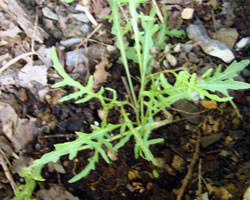

Courtesy Rick Gush
I plant cultivated arugula seeds densly, so I can harvest seedlings in early fall.
It’s the changing of the seasons now, and this means that we’ll switch arugula types for the next six months. We’ve been eating wild arugula since last April, and now, we’ll start eating the cultivated type.
It would be an understatement to say that the wild stuff reseeds itself. I did plant some wild arugula six or seven years ago, but since then, every spring a whole bunch of new wild arugula plants pop up all over the garden. I rip out most of them, but let a few patches remain in places where they don’t interfere with the other plantings. In general, the wild arugula grows in either full sun or partial, but the plants that grow in partial sun produce the biggest leaves. Not only are the big leaves easier to harvest, they’re also crunchier.
The cultivated arugula, on the other hand, does best when planted in full sun during the cold months. It will grow in shadier spots, but the plants in the full sun make the biggest and crunchiest leaves.
One trick I use to get harvestable arugula earlier in fall is to seed some areas quite thickly and then use scissors to harvest whole handfuls of the seedlings. The bed in the photo above is such a bed. I seeded it about two weeks ago, and we’ll be able to harvest really nice bunches of juvenile leaves in another week or so.

Photo by Rick Gush
Wild arugula’s has more pointed leaves than cutivated arugula.
The botanical name of the cultivated arugula is Eruca sativa. It’s a member of the Brassicaceae family, like cabbages and the mustards. Wild arugula is Diplotaxis tenuifolia, also in the same family. There are a few different cultivars or subspecies for the Erucas, but here in Italy, the sativa seems to be the more common. The photo to the right shows a wild arugula seedling. It’s easy to differentiate the two types, as the cultivated type has much more rounded lobes, while the wild type can be quite pointed. Both types are native to the Mediterranean and European area, but the Diplotaxis is the more common weed.
My English friends here all call these plants “Rocket” or “Roquette.” The Italians call both types ruccola, and they eat a lot of it. There’s hardly a day during the year when the local vegetable sellers at the market in Rapallo aren’t selling bunches of ruccola. A small bunch, about one handful of leaves, usually costs about one euro per bunch. That might sound like a lot, but considering that each leaf is picked separately, it’s a reasonable price for all that work.




